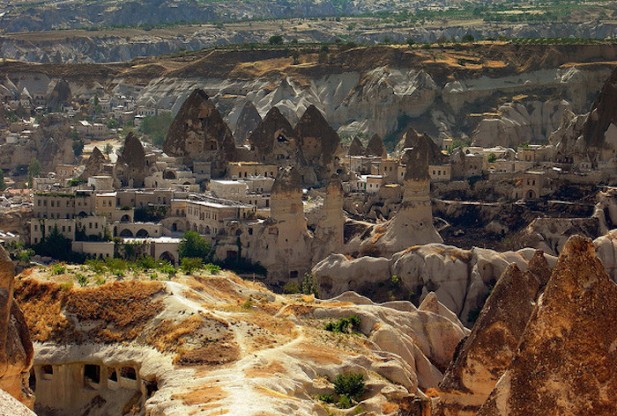
© Dachalan/FlickrA view of Nevşehir, a city near where the underground city was found.
In 2013, workers in Turkey looking to demolish low-income housing near a Byzantine-era hilltop castle stumbled upon something extraordinary:
an expansive underground city that may have housed 20,000 people or more.We think they actually found a huge Diglett sanctuary.
Located in the middle of the country near the provincial capital of in Nevşehir, the underground network has yet to be extensively explored by researchers. Archaeologists and geophysicists do have resources for their explorations in the form of a 300-year-old paper trail stretching all the way back to the Ottoman Empire.
"We found documents stating that there were close to 30 major water tunnels in this region," Nevşehir mayor Hasan Ünver
told National Geographic.
In 2014, those documents led researchers to
a multi-level underground village of living areas, wineries, chapels, and bezirhane-linseed presses for generating lamp oil. The research team was able to find numerous small artifacts, including stone crosses and ceramics. The artifacts reveal that the settlement was used from the Byzantine era all the way up to the Ottoman conquest, researchers said.
The team said that the newly discovered site appears to be similar to a nearby underground settlement called Derinkuyu, with airshafts and water channels designed to sustain life. The scientists said that residents probably retreated underground when attacked by marauders, blocking access to tunnels with round stone doors. There were then able to sustain themselves with livestock and supplies for some time, allowing them to wait out the threat.
In addition to archeological investigations, geophysicists from Nevşehir University executed an organized survey of the surrounding area using two different techniques.
From the 33 separate measurements they took, they determined that the total size of the archeological site is almost 5 million square feet.The team of archeologists investigating the site plans to continue clearing rubble from tunnels and move deeper underground. It's a risky move, as the team needs to be wary of the tunnels collapsing.
In addition to the scientific importance of the find, Turkish Mayor Ünver was delighted to say that the ancient underground system will be incorporated into the cultural tourism of the entire area.
"This new discovery will be added as a new pearl, a new diamond, a new gold" to the area, Ünver said, noting plans for "the world's largest antique park" in the area. Ünver said the park would include boutique hotels and art galleries above ground, and a museum below.
"We even plan to reopen the underground churches," he said. "All of this makes us very excited."
Comment: It seems illogical to construct such a vast underground settlement that has everything to sustain life for a long period of time, only in order to hide from the marauders. It appears that the real reason may be a very different one.
Also, nearly 135 years ago Gurdjieff discovered a similar underground city in the neighboring Armenia. Could there be a connection between two vast and complicated underground networks?